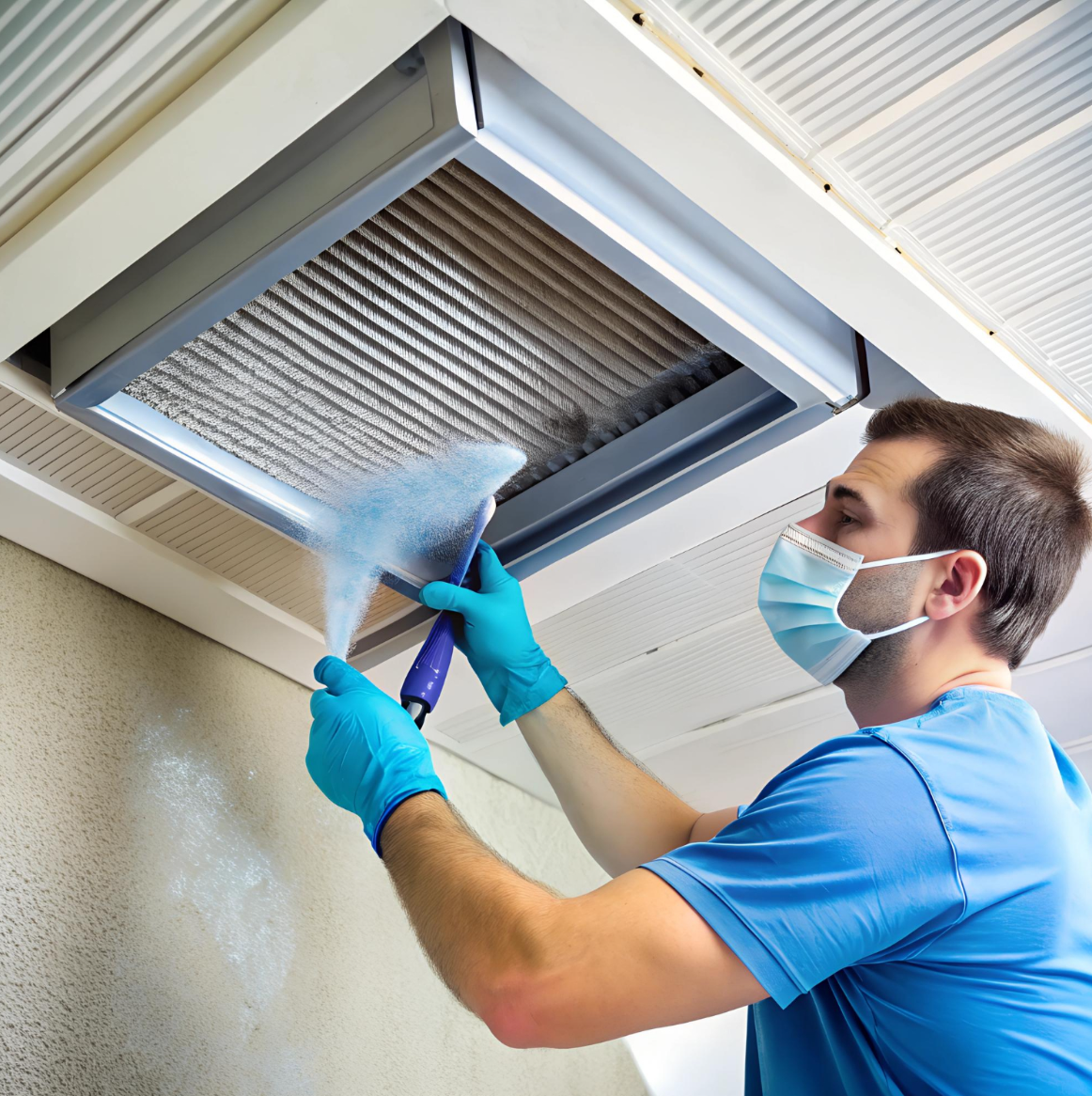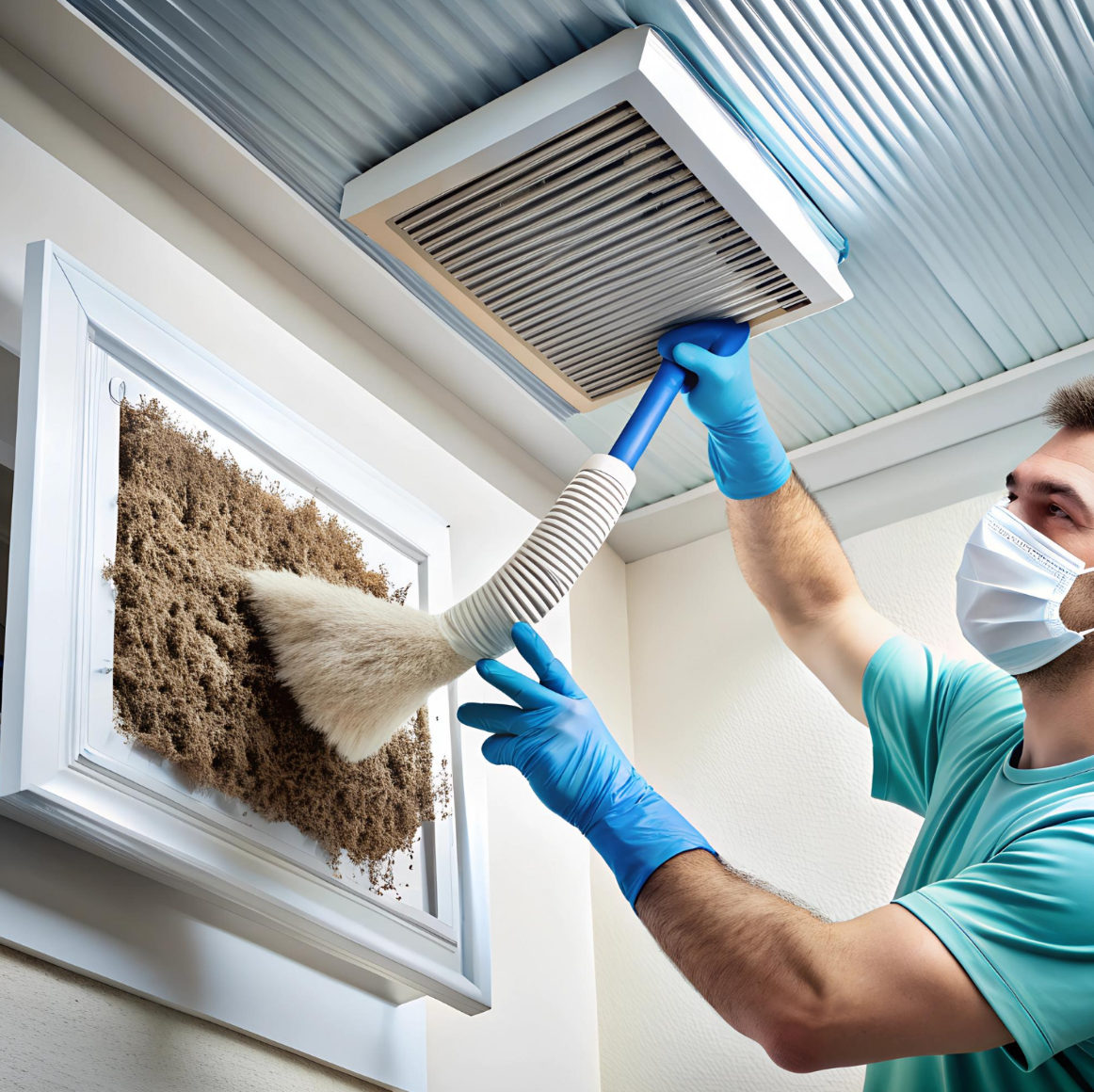Air ducts play a crucial role in your home by circulating air from your heating, ventilation, and air conditioning (HVAC) system into every room, ensuring consistent indoor comfort. However, over time, dust, debris, mould, and other contaminants can accumulate in these ducts, leading to poor air quality and higher energy bills. Cleaning your air ducts yourself is an effective way to improve indoor air quality and save on HVAC maintenance costs. In this comprehensive guide, we’ll walk you through the step-by-step process of cleaning your air ducts at home.
Why Should You Clean Your Air Ducts?
Before diving into the process, it’s essential to understand why air duct cleaning is necessary. Here are some of the key reasons:
- Improved Indoor Air Quality: Air ducts can accumulate dust, dirt, pet dander, pollen, and other allergens. Cleaning them regularly ensures that the air circulating in your home is clean and free of contaminants.
- Increased HVAC Efficiency: Dirty ducts make your HVAC system work harder, which increases energy consumption and shortens the lifespan of the system. Clean air ducts help maintain optimal airflow, improving efficiency.
- Reduced Allergies and Irritation: Dust, mould, and other particles circulating in the air can exacerbate allergies and respiratory issues. Keeping your ducts clean can minimize these irritants.
- Elimination of Unpleasant Odours: Over time, odours from cooking, pets, mould, and household cleaners can settle in your ducts. Cleaning helps remove these smells, leaving your home fresher.
- Cost Savings: Cleaning your air ducts yourself can save you a significant amount of money compared to hiring professional services.
How Often Should You Clean Your Air Ducts?
It's recommended to clean your air ducts every 3-5 years, depending on several factors:
- If you have pets that shed fur, more frequent cleaning is needed.
- People with allergies or respiratory conditions may benefit from cleaning ducts every 2-3 years.
- If you’ve recently renovated your home, construction dust can accumulate in the ducts, necessitating an immediate cleaning.

Tools and Equipment You Will Need
To clean your air ducts yourself, you’ll need the following tools and equipment:
- Vacuum Cleaner: A heavy-duty vacuum cleaner with a long hose attachment works best.
- Brushes: A stiff-bristle brush or a brush designed for cleaning air ducts is ideal.
- Screwdriver or Drill: To remove vent covers and access the ducts.
- Microfiber Cloths: For wiping down vent covers and other surfaces.
- Furnace Filter: Replace the old filter after cleaning to maintain air quality.
- Flashlight: Helps you see inside the ducts.
- Protective Gear: Wear a mask, gloves, and goggles to protect yourself from dust and allergens.
Step-by-Step Guide to Cleaning Air Ducts
Step 1: Turn Off Your HVAC System
Before starting the cleaning process, turn off your HVAC system to ensure that air is not blowing through the ducts while you work. This will also prevent debris from being circulated around your home during cleaning.
Step 2: Access the Air Ducts
Locate the air vents and registers in your home. These are typically found on floors, walls, or ceilings. Using a screwdriver or drill, remove the vent covers or grilles, and set them aside.
Tip: You may want to take photos of the vent covers before removing them so you can easily reinstall them later.
Step 3: Clean the Vent Covers
While the vent covers are removed, take the opportunity to clean them thoroughly. Use a microfiber cloth to wipe off any dust, and if they’re especially dirty, soak them in warm soapy water and scrub gently with a brush. Allow them to air dry completely before reattaching them.
Step 4: Loosen the Dust and Debris in the Ducts
Using your brush, gently scrub the interior of the air ducts to loosen any dust, dirt, or debris. Focus on the areas close to the opening of the duct, as that’s where most dirt tends to accumulate. If you have access to longer brushes specifically designed for duct cleaning, you can push them further into the ducts.
Caution: Be gentle while scrubbing to avoid damaging the ducts or dislodging any internal components.
Step 5: Vacuum the Air Ducts
With the dust and debris loosened, it’s time to vacuum the ducts. Attach a long hose to your vacuum cleaner and insert it into the air ducts as far as it can reach. Turn on the vacuum and run it along the length of the ducts, moving the hose back and forth to pick up as much debris as possible.
If your vacuum doesn’t reach the entire length of the ducts, consider renting a duct cleaning vacuum from a hardware store. These are designed specifically for this task and come with longer hoses and powerful suction.
Step 6: Clean the Supply Registers and Return Ducts
After vacuuming the ducts, move on to cleaning the supply registers and return ducts. These areas tend to collect dust and dirt as air circulates through your home. Use the vacuum and brush to remove any visible debris, ensuring that airflow isn’t obstructed.
Step 7: Clean the Blower Compartment
The blower compartment is another area that can accumulate dust and debris. Carefully open the compartment, and using your vacuum and brush, remove any dust inside. The blower fan and motor should also be cleaned, as dirt can hinder their performance.
Note: If you’re unsure how to access the blower compartment or feel uncomfortable handling it, consult your HVAC system’s manual or consider leaving this step to a professional.
Step 8: Replace the Furnace Filter
After you’ve finished cleaning the ducts and blower compartment, replace the old furnace filter with a new one. This is a critical step because a dirty filter can undo all your hard work by allowing dust and debris to re-enter the ducts.
Pro Tip: Choose a high-quality filter that fits your HVAC system properly. A good filter will trap more dust and allergens, improving air quality and extending the time between cleanings.
Step 9: Reattach the Vent Covers
Once the ducts, registers, and blower compartment are clean, it’s time to reinstall the vent covers. Make sure they are completely dry before reattaching them. Use your screwdriver or drill to secure them back in place.
Step 10: Turn On Your HVAC System
Now that everything is cleaned and reassembled, turn your HVAC system back on. Listen for any unusual noises, and check that air is flowing freely from the registers. If everything seems in order, your cleaning process is complete!

Additional Tips for Maintaining Clean Air Ducts
While a thorough cleaning every few years is necessary, here are some additional steps you can take to maintain clean air ducts in between cleanings:
- Change Air Filters Regularly: Replace your HVAC air filter every 1-3 months, depending on the manufacturer’s recommendations and your home’s conditions.
- Vacuum Your Home Frequently: Regular vacuuming helps reduce the amount of dust and debris that enters your ducts.
- Use Air Purifiers: Air purifiers can help capture dust and allergens before they settle into your ducts.
- Seal Air Leaks: Make sure your ducts are properly sealed, as leaks can allow dust and debris to enter the system.
- Keep Vents Clear: Ensure that furniture or other objects don’t block your vents, as this can obstruct airflow and increase the accumulation of dust.
- In addition to cleaning your air ducts, dryer vent cleaning is essential for maintaining a safe and efficient home. Over time, lint and debris can accumulate in the dryer vent, reducing airflow and causing your dryer to work harder. This buildup not only affects efficiency but also poses a serious fire hazard. Regularly cleaning the dryer vent ensures proper airflow, reduces energy costs, and extends the life of your dryer. To clean your dryer vent, disconnect the dryer, remove the vent cover, and use a brush or vacuum to clear out the lint, ensuring a safe and efficient system.
When to Call a Professional
While cleaning your air ducts yourself can be effective, there are times when calling a professional is the better option. Here are a few signs that you may need professional assistance:
- Mold Growth: If you notice visible mold growth inside your ducts, it's best to contact a professional who has the right equipment to remove it safely.
- Rodent or Insect Infestations: Signs of rodent droppings, insects, or nests in your ducts should be handled by professionals to ensure thorough cleaning.
- Persistent Odors: If there’s a strong, persistent odor coming from your ducts, a professional cleaning might be necessary to eliminate it.
- Severe Allergies or Respiratory Issues: If someone in your household has severe allergies or respiratory issues, it’s worth hiring a professional to ensure the most thorough cleaning possible.
Conclusion
Cleaning your air ducts yourself is a task that can be completed with basic tools and a little time. By following this step-by-step guide, you can improve your home’s air quality, increase the efficiency of your HVAC system, and create a healthier living environment for you and your family. While it’s not a task that needs to be done frequently, regular maintenance and cleaning will help ensure your HVAC system runs smoothly and your indoor air stays fresh and clean.

